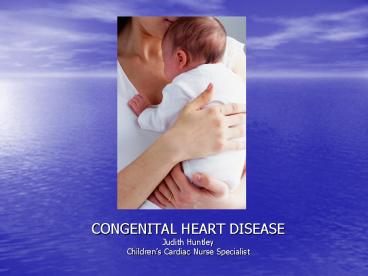CONGENITAL HEART DISEASE - PowerPoint PPT Presentation
1 / 18
Title:
CONGENITAL HEART DISEASE
Description:
... Atrial Septal Defect Ventricular Septal Defect Persistant Ductus Arteriosus There is no mixing of oxygenated and deoxygenated blood in these ... – PowerPoint PPT presentation
Number of Views:128
Avg rating:3.0/5.0
Title: CONGENITAL HEART DISEASE
1
- CONGENITAL HEART DISEASE
- Judith Huntley
- Childrens Cardiac Nurse Specialist
2
- Present from birth
- Incidence in full term live born infants is
between 4 and 9 / 1000 - Each year there are about 1.5 million new cases
worldwide. - It is the most common congenital condition
diagnosed in newborns.
3
- The prognosis for children with congenital heart
disease has improved dramatically over the last
20 years. - In 1986 60 of deaths from congenital heart
disease occurred in the first year of life - In the 1990s the majority of deaths occurred in
adults over the age of 20. - It is predicted that 78 of the babies born with
congenital heart disease today will survive into
adulthood.
4
Aetiology
- Exact cause of most incidences is unknown
- Defects occur when there is abnormal embryonic
development or persistence of foetal circulation
past delivery
5
Some possible risk factors in pregnancy are
- Use of certain prescription drugs
- eg. Carbamazapine
- Use of illegal drugs
- Use of alcohol
- Foetal/maternal infection
- eg. Rubella
- vaccination has reduced the number of
children born with rubella syndrome in the last
two decades. Reduced uptake of the MMR vaccine
could allow congenital rubella to increase again.
6
- Maternal dietary deficiencies
- Hereditary/familial tendencies
- Often associated with other congenital problems
- eg. Downs Syndrome
- 40 of babies with Downs Syndrome will
- have a heart defect
7
Structural defects can be divided into 2 main
categories
- ACYANOTIC
- These defects can be obstructive
- Pulmonary Stenosis
- Aortic Stenosis
- Coarctation of the Aorta
8
- left to right shunts
- Atrial Septal Defect
- Ventricular Septal Defect
- Persistant Ductus Arteriosus
- There is no mixing of oxygenated and
deoxygenated blood in these lesions.
9
- CYANOTIC
- Right to left shunts
- Tetralogy of Fallots
- Tricuspid Atresia
- Transposition of Great Arteries
- Deoxygenated blood mixes with oxygenate blood
10
Diagnosis
- HISTORY
- Poor weight gain
- Poor feeding
- Frequent respiratory problems
- Fatigue
- cyanosis
11
- PHYSICAL
- Cyanosis
- Pallor
- Behaviour
- Dyspnoea
- Heart rate
- Murmur
- Hepatomegaly
- Pulses
12
- CHEST X-RAY
- Size of heart
- Shape of heart
- ECHO
- Structure and function
13
- ECG
- Arrhythmia
- Electrolyte imbalance
- Myocardial hypertrophy / damage
- CARDIAC CATHETER
- Diagnostic / theraputic
14
- What is a murmur?
- What does having a murmur mean?
- A murmur is a noise made by blood moving through
the heart. - A murmur does not automatically mean that
someone has a heart defect - Murmurs can be INNOCENT and caused by normal flow
of blood around the heart
15
(No Transcript)
16
Heart Failure
- Inability of the heart to pump an adequate amount
of oxygenated blood to the systemic circulation
to meet the bodies metabolic demands. - Many children with a congenital heart defect will
suffer from a greater or lesser degree of heart
failure.
17
- Signs Symptoms
- Tachycardia
- Tachypnoea
- Hepatomegaly
- Cardiomegaly
- Cough
- Sweating
- Oedema
- Vomiting
18
(No Transcript)































